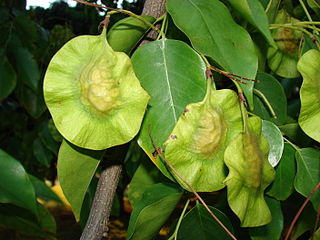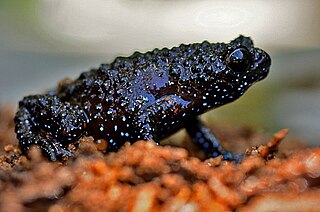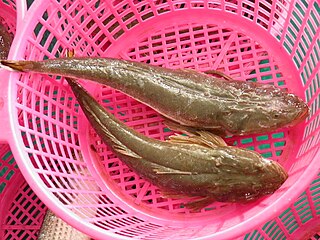
Pterocarpus is a pantropical genus of trees in the family Fabaceae. It belongs to the subfamily Faboideae, and was recently assigned to the informal monophyletic Pterocarpus clade within the Dalbergieae. Most species of Pterocarpus yield valuable timber traded as padauk ; other common names are mukwa or narra. P. santalinus also yields the most precious rosewood in China known as Zitan. The wood from the narra tree and the Burmese padauk tree is marketed as amboyna when it has grown in the burl form. The scientific name is Latinized Ancient Greek and means "wing fruit", referring to the unusual shape of the seed pods in this genus.

Kurtus is a genus of percomorph fishes, called the nurseryfishes, forehead brooders, or incubator fish, native to fresh, brackish and coastal marine waters ranging from India, through southeast Asia to New Guinea and northern Australia. Kurtus is currently the only known genus in the family Kurtidae, one of two families in the order Kurtiformes. They are famous for carrying their egg clusters on hooks protruding from the forehead (supraoccipital) of the males, although this only has been documented in K. gulliveri and available evidence strongly suggests this is not done by K. indicus. Females do not have a hook.

The bronze-winged jacana is a wader in the family Jacanidae. Like other jacanas it forages on lilies and other floating aquatic vegetation, the long feet spreading out its weight and preventing sinking. It is found across South and Southeast Asia and is the sole species in the genus Metopidius. The sexes are alike but females are slightly larger and polyandrous, maintaining harems of males during the breeding season, in the monsoon rains. Males maintain territories, with one male in the harem chosen to incubate the eggs and take care of the young. When threatened, young chicks may be held and carried under his wings to safety by the male.
Chrysiogenaceae is a bacterial family.

Hirundichthys is a genus of flying fish. They have elongated, moderately thick, ventrally flattened bodies. The pectoral branch of the lateral line is absent. The upper jaw is not protrusible. The dorsal fin has fewer or equal rays than the anal fin; the dorsal fin is low, with the anterior rays the longest, the pectoral fins are strikingly long, reaching to or almost to caudal fin base; pelvic fins are long, reaching beyond the anal fin origin, and their insertion is closer to the anal fin origin than to the pectoral fin insertion.

Mucor is a microbial genus of approximately 40 species of moulds commonly found in soil, digestive systems, plant surfaces, some cheeses like tomme de savoie, rotten vegetable matter and iron oxide residue in the biosorption process.

Melanobatrachus is a genus of narrow-mouthed frogs that contains a single species, Melanobatrachus indicus. It is known under a number of common names, including Indian black microhylid frog and Malabar black narrow-mouthed frog. It is endemic to wet evergreen forests of southern Western Ghats in Kerala and Tamil Nadu states of India. It has been recorded from Anaimalai, Munnar, Palni hills, Periyar Tiger Reserve and Kalakkad Mundanthurai Tiger Reserve

Scomber is a genus of fish in the family Scombridae living in the open ocean found in Atlantic, Indian and Pacific Ocean. The genus Scomber and the genus Rastrelliger comprise the tribe Scombrini, known as the "true mackerels". These fishes have an elongated body, highly streamlined, muscular and agile. The eyes are large, the head is elongated, with a big mouth provided with teeth. They have two dorsal triangular fins, with some stabilizing fins along the caudal peduncle. The basic color is blue-green with a silvery white belly and a darker back, usually black mottled.

The bartail flathead, also called bar-tailed flathead, bartail blenny, gobi, Indian flathead, or Indo-Pacific flathead, is the type species for the fish genus Platycephalus. It is found in the Indian Ocean and western Pacific Ocean. The species has been recorded in the Mediterranean, having invaded as a Lessepsian migrant through the Suez Canal. However, although a number of specimens were caught in trawls in the late 1970s then none were caught until 2011, when one was taken off Lebanon. Following the revision of genus Platycephalus in Australia, Australian specimens previously assigned to this species are now considered a separate species, Platycephalus australis.
Copelatus indicus is a species of diving beetle. It is part of the genus Copelatus of the subfamily Copelatinae and the family Dytiscidae. It was described by Sharp in 1882.
Oryctocephalus indicus is a species of corynexochid trilobite from the Cambrian. Its first appearance is proposed for the lower boundary of the Wuliuan, which corresponds to the beginning of the Miaolingian. The species was first described by the British paleontologist Frederick Richard Cowper Reed in 1910 as Zacanthoides indicus. It was transferred to the genus Oryctocephalus by the American paleontologist Charles Elmer Resser in 1938.

Olenecamptus is a genus of longhorn beetles of the subfamily Lamiinae.
Microlenecamptus biocellatus is a species of beetle in the family Cerambycidae. It was described by Schwarzer in 1925, originally under the genus Olenecamptus.
Olenecamptus griseipennis is a species of beetle in the family Cerambycidae. It was described by Pic in 1932, originally under the genus Cylindrepomus.

Olenecamptus bilobus is a species of beetle in the family Cerambycidae. It was described by Johan Christian Fabricius in 1801, originally under the genus Saperda. It is known from Myanmar, India, Papua New Guinea, Indonesia, Laos, Seychelles, Madagascar, Australia, Sri Lanka, Japan, Sumatra, Java, Philippines and Taiwan.
Olenecamptus indianus is a species of beetle in the family Cerambycidae. It was described by Thomson in 1857, originally under the genus Authades. It is known from Myanmar, Malaysia, Vietnam, Thailand, and India. It contains the varietas Olenecamptus indianus var. salweeni.
Olenecamptus octopustulatus is a species of beetle in the family Cerambycidae. It was described by Motschulsky in 1860, originally under the genus Ibidiomorphum. It is known from Mongolia.











